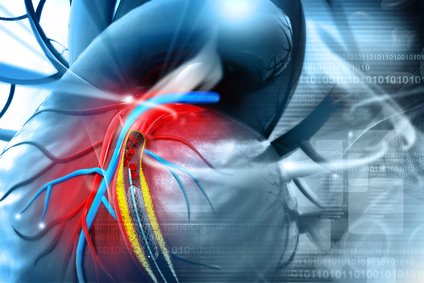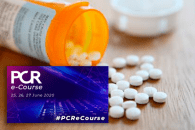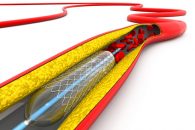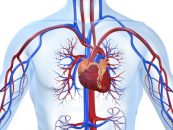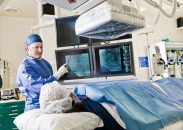Courtesy of Dr. Carlos Fava. Bifurcation lesions account for about 25% of all angioplasties and it is a challenge for which there is no single treatment strategy. Intravascular ultrasound (IVUS) has proven its usefulness, improving outcomes by reducing mortality in unprotected left main coronary artery (LMCA) angioplasty. A new strategy consists in conducting an IVUS after…
EuroPCR 2020 | FABOLUS FASTER: In the Quest for the Fastest, Most Potent Platelet Inhibition
This small study tested the pharmacodynamic effects of several antiplatelet agents. It concluded that tirofiban (Aggrastat) provides “more potent and consistent” inhibition of platelet aggregation compared with cangrelor in patients with ST-segment elevation myocardial infarction undergoing primary angioplasty. Thirty minutes after the initiation of treatment, there was a nearly threefold difference between tirofiban and cangrelor…
EuroPCR 2020 | Deferral Based on iFR vs. FFR: Are They Equivalent or Is There a New “Gold Standard”?
Age may impact results when making an angioplasty choice based on fractional flow reserve (FFR) vs. instantaneous wave-free ratio (iFR). After 2 years of follow-up, patients whose treatment of intermediate lesions was deferred based on functional testing had similar outcomes regardless of whether this decision was informed by FFR or iFR. However, iFR performance was constant,…
EuroPCR 2020 | Revascularization vs. Initial Medical Treatment in Chronic Patients
There is no survival advantage with invasive coronary revascularization over initial medical treatment in patients with chronic coronary artery disease. However, revascularization did reduce the incidence of unstable angina and its symptoms, according to this new meta-analysis published in Circulation and presented virtually at EuroPCR 2020. There was no significant difference in spontaneous infarctions overall, but…
EuroPCR 2020 | Sudden Death Increase Two to Three Times While MI Rate Falls
The number of sudden deaths reported around the world is on the rise in Covid-19 times. These deaths are caused either by the virus and its capacity to produce lethal arrhythmias or by the fact that patients are staying away from hospitals and are not being examined. Cardiologists were the first to warn that the…
Olive Oil and Cardiovascular Risk: The Higher the Consumption, the Lower the Risk?
High olive oil intake was associated with lower risk of coronary heart disease and cardiovascular disease in two large prospective cohorts of men and women. The substitution of margarine, butter, mayonnaise, and dairy fat with olive oil can have a significant impact on cardiovascular health. The benefits of olive oil intake have been well studied…
Effects of Health Promotion Since Childhood
All clinical practice guidelines indicate healthy lifestyle recommendations and, as cardiologists, we have slowly but surely implemented such practice. However, patients come to us once they have had health problems. What would happen if people had these recommendations at an earlier stage in their life? Would that prevent them from ever becoming patients? There was…
Myocardial Injury in One Third of COVID-19 Patients
Roughly one third of patients hospitalized for COVID-19 have some degree of myocardial injury and this comes hand in hand with increased mortality compared against patients with no troponin elevation. Even mild forms of myocardial injury, such as 0.03 to 0.09 ng/mL troponin elevation, is associated with close to 100% increase in mortality (HR: 1.75;…
Stenting of Lipid-Rich vs Fibrous and calcified Plaques: Different Prognosis?
Coronary PCI with contemporary drug eluting stents (DES) in lipidic-rich plaques were not associated with increased periprocedural events at long term compared against plaques with no significant lipidic composition. This study recently published in J Am Coll Cardiol looked into the association between lipidic rich plaques detected by near-infrared spectroscopy (NIRS) and clinical events in…
Non-Invasive Diagnosis of Coronary Spasm: Can We Recommend it?
Conventional non-invasive testing to detect obstructive coronary artery disease (CAD) by induced myocardial ischemia are not useful to diagnose epicardial or microvascular coronary artery spasm. Invasive testing requires the intracoronary injection of acetylcholine or ergonovine (the latter can also be endovenous). These tests are more often done in Asian countries, and rarely done in…
Is the Use of iFR for the Deferral of Left Main Coronary Artery Lesions Safe?
Deferral of left main coronary artery lesions using instantaneous wave-free ratio (iFR) seems to be safe. At the least, patients with deferred lesions had similar long-term prognosis to that of patients who underwent revascularization based on that same indicator. Left main coronary artery lesions were universally excluded from studies including medical treatment among the therapeutic…
